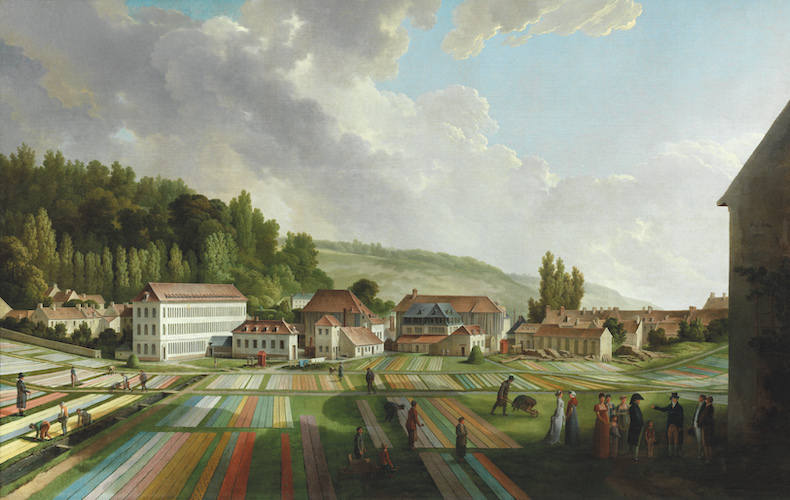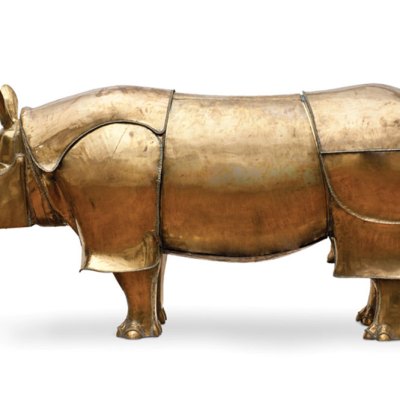From the June 2024 issue of Apollo. Preview and subscribe here.
The small town of Jouy-en-Josas is a short train ride from Paris, four kilometres south-east of Versailles. Wandering through this sleepy sylvan suburb, the visitor is hard-pressed to find any trace of what was, at the turn of the 19th century, France’s third-largest industry. For this was the site of the Oberkampf Manufactory, which from 1760 to 1843 delighted everyone from Marie-Antoinette and Josephine Bonaparte to papal and Persian ambassadors with its printed cloth of arcadian scenes and delicate blooms – or, as it came to be known, toile de Jouy.
What today serves as the town hall is one of the few buildings left from that period – one wing of the family home built in 1766 for the manufactory’s German-born founder, Christophe-Philippe Oberkampf. A more eloquent relic of this hive of industry stands in the mairie’s courtyard: the factory bell in its tall wooden frame, rung each morning to signal the opening of the gates to Oberkampf’s 14-hectare production site. At its height, more than 1,300 employees, from illustrators and engravers to gamins épingleurs (kids who pegged out the fabric to bleach under the sun), worked in and around the manufactory’s 36 buildings to make hundreds of kilometres of printed toiles each year.
West of the town centre, a compact late 19th-century chateau houses the Musée de la Toile de Jouy. Here, vitrines of textiles, costumes and swatch books begin by illustrating the history of printed cottons and their origins in India. In the 17th century the European appetite for these highly coloured, usually floral indiennes for furnishings and clothing was such that, to protect the domestic silk and wool industries, the French government imposed a ban on their importation in 1686, and soon after on their imitation. A healthy black market developed until, after a gradual relaxation of the rules, the ban was lifted outright in 1759. At that point, demand for colourfast toiles peintes exploded, and it was in this newly favourable climate that Oberkampf set up in Jouy.
The Activities of the Factory (1783; detail), designed by Jean-Baptiste Huet for the Oberkampf Manufactory. Metropolitan Museum of Art, New York

Born in Württemberg in 1738, Oberkampf was apprenticed at an early age in the family’s dyeing business. Work took him first to Switzerland and then to a textile company in Paris, where he was hired as a colourist and engraver before being promoted to director. With the revocation of the ban on printed cotton imminent, the young entrepreneur looked about for a location to set up his own manufactory. Jouy was ideal, lying as it does on the river Bièvre – a good water supply for washing and softening the fabric was essential – and offering proximity to Paris and Versailles. An old riverside house in town – today a music school – provided a makeshift workshop, and it was from there that the very first toile de Jouy was printed in May 1760, designed – as were many of the company’s early fabrics – by Oberkampf himself. The museum displays an example from around this time titled Chinese Man with Barrow, the figures and scenes block-printed in blue on a white ground. Oberkampf borrowed the design from Livre de Dessins Chinois, a book of prints by Jean-Antoine Fraisse published in 1735.
Of the 30,000-odd designs it produced, the manufactory would print many more floral patterns than figurative motifs; but it was the latter – often in red on an off-white ground – that would come to be synonymous with ‘toile de Jouy’. And the artist who would distinguish the Oberkampf brand in this genre was Jean-Baptiste Huet (1745–1811), Parisian painter of animals and Boucher-style pastoral scenes. In one corner of the museum hangs a charming engraving by him of 12 animal heads, most of them bulls. The technical precision on display here lent itself to designing toiles such as The Activities of the Farm or The Pleasures of the Countryside – playful fantasies of rural life that might make even the most determined urbanite pack their bags and head for pastures green.
The Oberkampf Manufactory at Jouy-en-Josas (1807), Jean-Baptiste Huet. Musée de la Toile de Jouy, Jouy-en-Josas. Photo: © Manufacture Oberkampf/Musée de la Toile de Jouy

Copperplate printing, developed in Ireland in 1752 and adopted by Oberkampf in 1770, made possible such sharp and detailed image-making, as well as a surge in annual production – from 82km of printed toiles in 1761 to around 600km in 1777. By this time Oberkampf had bought from the seigneur de Jouy the land needed for such an operation. A large-scale oil by Huet from 1807 depicts the manufactory and its collection of industrial buildings in the landscape. Most of the foreground is taken up with long strips of colour stretched out rainbow-like across the fields – precious lengths of toile being dried or sun-bleached to remove any unwanted ground colour.
This represents just one of some 20 stages in what was a highly involved process, involving everything from beating the fabric in the river to bathing it in a solution of cow dung. While a long corridor in the museum is helpfully decorated with illustrations to explain each stage, a more poetic version of this can be found among the toiles themselves. The Activities of the Factory, printed in 1783 to a design by Huet, contains 14 different scenes of Oberkampf industry: here are figures washing the fabric, here singeing it to burn off loose fibres; here lengths of it are hung like ribbons to dry from the eaves of a warehouse, or pressed through rollers. Here are dyers, engravers and pinceauteuses – women who painted finishing touches or minor corrections to a printed toile (at one point almost half the workforce was female, including a Mademoiselle Jouanon, the only woman to be appointed among the designers). Oberkampf himself is there, with one of his children; as is Huet, sketching. Even the factory bell makes an appearance. The level of detail is extraordinary, with the figures on a printed length of toile (this very one, perhaps?) visible, along with its chef de pièce, or factory mark: ‘Manufacture Royale de SDM. Oberkampf’.
The Monuments of Egypt (c. 1808), designed by Jean-Baptiste Huet after a design by Louis-François Cassas for the Oberkampf Manufactory. Metropolitan Museum of Art, New York

The manufactory had in fact just been awarded its royal title, and this design had been commissioned from Huet to mark the occasion. In just a few years, of course, the ‘royale’ in the mark would be dropped, yet the company weathered Revolutionary upheaval well; Oberkampf himself was appointed Jouy’s first mayor in 1790. He and his family were painted several times by Louis-Léopold Boilly. Napoleon’s great redecorating campaign brought the company continued custom from court (while his Egyptian campaign inspired The Monuments of Egypt toile). The emperor visited Jouy on more than one occasion, most significantly in 1806, when he awarded Oberkampf the Légion d’honneur on the spot – his bicorne-sporting figure is visible in the group gathered in the right-hand corner of Huet’s large oil painting of the manufactory, commissioned to commemorate the visit (the Empress Josephine, one of the party, also commissioned a visual record of the moment, from Jean-Baptiste Isabey).
Ironically, it was from around that time that Oberkampf’s business began to suffer the effects of the Napoleonic Wars; supplies of dyes and mordants for colour fixing were interrupted, and material prices soared. Oberkampf died in October 1815, having witnessed the shuttering of his manufactory while Jouy was occupied after Waterloo. The business limped on for some 30 years more, but finally closed in 1843, when its land was sold off and most of its buildings demolished. Yet, what a legacy: the piping swains and maidens that danced merrily out of its printing rooms two and a half centuries ago frolic across our decorative landscape still.
From the June 2024 issue of Apollo. Preview and subscribe here.


